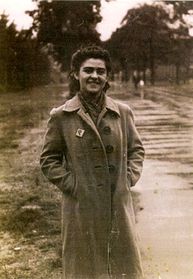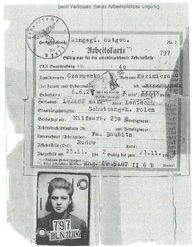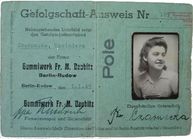Wednesday 11 April 1945
Kazimiera Kosonowska, geb. Czarnecka
Kazimiera Kosonowska, née Czarnecka
"In April, the carpet bombing begins. At a not too high altitude, whole squadrons of planes fly and systematically bomb the city. During an air raid, other factory buildings are destroyed. Dutchmen try to put out the fire and protect the rest of the buildings."
"One sunny day in April, a large group of us and the guard drive directly from the factory into town. With astonishment we discover that we arrive at a large and beautiful Charlottenburg cemetery. Dozens of coffins are standing on the carefully maintained paths, waiting for burial; they are the victims of the latest attacks. The cemetery staff shows us the places, and we are forced to dig the graves."
"Chaos and panic breaks out among the Germans. For a few days now, in a hurry, day and night, countless columns of military cars and other heavy vehicles have been driving by. You can hear the constant hum of the engines. In the streets you can see older men and very young boys ready to defend the city. After the panic-like retreat of the German troops, it suddenly becomes quiet. There is a strange calm, like before the storm, which lasts all day long."
(Letter from the former forced labourer Kazimiera Kosonowska to the Berlin History Workshop).
Kazimiera Czarnecka helps her father in the forge after finishing primary school. A longer school attendance is not possible, because the German occupying forces have closed all secondary schools. On 14 November 1942 she has to report to the German employment office under threat of a penalty for the whole family. At the age of 18 she is deported from there directly to the German Reich. In the transit camp in Berlin-Wilhelmshagen, a representative of the "Gummiwerk Fr. M. Daubitz" company, Kazimiera Czarnecka, chooses Kazimiera Czarnecka as a forced labourer. She is taken to a collection camp in Berlin-Adlershof, which had previously been occupied by prisoners of war. From there, Kazimiera Kosonowska has to walk 1.5 kilometres every day to the rubber factory of the Daubitz company, where she works under the most difficult conditions in the production of rubber gloves for the Wehrmacht.
At the end of the year, the company's staff moves to a camp in Köpenicker Strasse in Rudow. Kosonowska works 10 hours a day, there is no medical care in the camp. Like all Polish forced laborers, she has to wear the "P" badge on her clothes, always visible. After all the deductions, hardly anything remains of her supposed wage. In May 1943 Kosonowska makes friends with young Poles from a camp in Grünau. This friendship promotes her will to self-preservation.
During the ever-increasing air raids, Kosonowska tries to protect herself and other forced laborers in trenches covered with wooden boards behind the barracks. In a letter to the Berlin History Workshop, she impressively describes the last months and weeks before the liberation.


